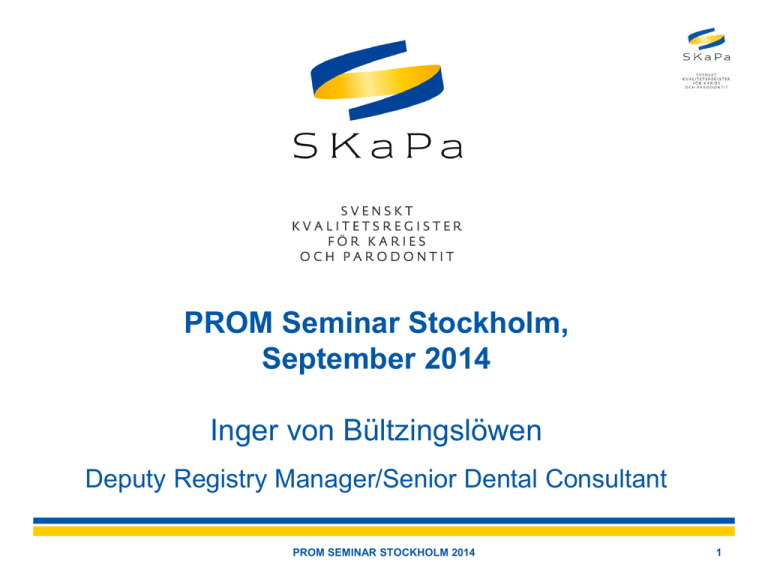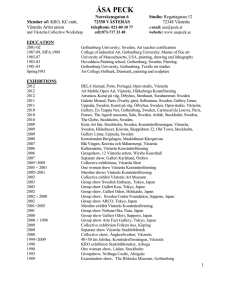PROM Seminar Stockholm, September 2014
advertisement

PROM Seminar Stockholm, September 2014 Inger von Bültzingslöwen Deputy Registry Manager/Senior Dental Consultant PROM SEMINAR STOCKHOLM 2014 1 The Swedish Quality Registry for caries and periodontal disease PROM SEMINAR STOCKHOLM 2014 2 OVERALL AIM of SKaPa – to promote high quality of care, patient safety and good oral health SPECIFIC AIMS • Follow up treatments and results in clinics and on a regional/national level • Compliance with national guidelines • Stimulate registry based research • Enable patient reported evaluations PROM SEMINAR STOCKHOLM 2014 3 OVERALL AIM of SKaPa – to promote high quality of care, patient safety and good oral health SPECIFIC AIMS • Follow up treatments and results in clinics & regional/national level • Compliance with national guidelines • Stimulate registry based research • Enable patient reported evaluations FORM THE BASIS TO promote quality development in dental care PROM SEMINAR STOCKHOLM 2014 4 The STRUCTURE of SKaPa Information is reported to SKaPa, not by dental health care personnel manually entering data on a web site, but data are being transferred via secured electronic files (automatic feed) from the dental health services electronic patient records to the quality registry database PROM SEMINAR STOCKHOLM 2014 The SKaPa main processes Care procedures Quality development Documentation in the operating room Electronic patient data record Reports Analyzes Automated extraction/transfer of information Loading & storage in SKaPa relational data base Public dental health care Private dental health care Grundkarta: SCB Grundkarta: SCB SKaPa now includes information about dental care concerning 2,1 million adults and 1,0 million children PROM SEMINAR STOCKHOLM 2014 7 OVERALL AIM of SKaPa – to promote high quality of care, patient safety and good oral health SPECIFIC AIMS • Enable follow-ups on • treatments and results in clinics & regional/national level • Follow-up on compliance with national guidelines • Stimulate registry based research • Enable patient reported evaluations (PROM/PREM) WHICH WILL FORM THE BASIS TO promote quality development PROM SEMINAR STOCKHOLM 2014 8 OVERALL AIM of SKaPa – to promote high quality of care, patient safety and good oral health SPECIFIC AIMS • Enable follow-ups on • treatments and results in clinics & regional/national level • Follow-up on compliance with national guidelines • Stimulate registry based research • Enable patient reported evaluations (PROM/PREM) WHICH WILL FORM THE BASIS TO promote quality development PROM SEMINAR STOCKHOLM 2014 9 Methods What have we done? I. Defined patient populations II. Constructed a questionnaire III. Distributed the questionnaire by regular mail - pilot studies IV. Analyses and conclusions. National reference group with 8 skilled researchers/practitioners EADPH Gothenburg 2014 10 I. Defined patient populations • low risk/healthy • patients with caries • patients with periodontal disease EADPH Gothenburg 2014 11 II. Constructed the questionnaire Two global questions1,2: HOW CONTENT ARE YOU WITH YOUR MOUTH AND TEETH? HOW WOULD YOU DESCRIBE YOUR ORAL HEALTH? 1. Does different wording of a global oral health question provide different results? Ekbäck G, Ordell S. Acta Odontol Scand. 2013 2. Pattussi MP, Olinto MT, Hardy R, Sheiham A. Clinical, social and psychosocial factors associated with self-rated oral health in Brazilian adolescents. Community Dent Oral Epidemiol. 2007;35(5):377-86 EADPH Gothenburg 2014 12 Two questions on patients’ awareness of disease: DO YOU CONSIDER YOURSELF HAVING PROBLEMS WITH CARIES? DO YOU CONSIDER YOURSELF HAVING PROBLEMS PERIODONTAL DISEASE? EADPH Gothenburg 2014 13 Disease specific questions, anticipated to be of specific importance for these patient groups: inspired by - works on oral health related QoL1, defining four aspects: Function (chewing, swallowing; speech) Social aspects (social interactions) Pain (acute; chronic) Psycosocial aspects (appearance; self esteeme) - validated scales e.g the Oral Health Impact Profile (OHIP)2 1 Inglehart MR, Bagramian RA. Oral health-related quality of life: An introduction I: oral health-related quality of life. Chicago: Quintessence 2002 2 Locker D, Jokovic A, Clarke M. Assessing the responsiveness of measures of oral health-related quality of life. Community Dent Oral Epidemiol. 2004;32:10-8 EADPH Gothenburg 2014 14 TO WHAT EXTENT HAVE YOU EXPERIENCED PROBLEMS WITH THE FOLLOWING ISSUES, BEFORE AND AFTER THE LATEST TREATMENT SESSIONS NOT AT ALL; A LITTLE; MODERATE; BIG; VERY BIG CHEWING BEFORE TREATMENT AFTER TREATMENT TASTE SPEECH CLEANING TEETH ORAL PAIN TEETH APPEARANCE EADPH Gothenburg 2014 15 PREM HAVE YOU FELT AS INCLUDED IN DECISION MAKING AS YOU WANTED, REGARDING YOUR DENTAL TREATMENTS? HAVE YOU RECEIVED INFORMATION FROM THE DENTAL TEAM ABOUT WHAT YOU CAN DO TO STAY HEALTHY? DO YOU THINK YOU WILL BE ABLE TO STAY HEALTHY? EADPH Gothenburg 2014 16 Frågor om din upplevelse av din munhälsa Mycket nöjd Nöjd Varken nöjd eller missnöjd Missnöjd Mycket missnöjd ☐ ☐ ☐ ☐ ☐ Mycket bra Bra Varken bra eller dåligt Dåligt Mycket dåligt ☐ ☐ ☐ ☐ ☐ Hur nöjd är du med din mun och dina tänder? Hur skulle du beskriva din munhälsa? Inga Små Måttliga Stora Mycket stora Anser du dig ha problem med karies (hål i tänderna)? ☐ ☐ ☐ ☐ ☐ Anser du dig ha problem med parodontit (tandlossning)? ☐ ☐ ☐ ☐ ☐ I vilken omfattning har du upplevt problem före och efter din senaste behandlingsomgång (kan innefatta flera besök) med följande: Inga Små Måttliga Stora Mycket stora ☐ ☐ ☐ ☐ ☐ ☐ ☐ ☐ ☐ ☐ ☐ ☐ ☐ ☐ ☐ ☐ ☐ ☐ ☐ ☐ ☐ ☐ ☐ ☐ ☐ ☐ ☐ ☐ ☐ ☐ ☐ ☐ ☐ ☐ ☐ ☐ ☐ ☐ ☐ ☐ ☐ ☐ ☐ ☐ ☐ ☐ ☐ ☐ ☐ ☐ ☐ ☐ ☐ ☐ ☐ ☐ ☐ ☐ ☐ ☐ Att tugga maten? - Före behandling - Efter behandling Att njuta av smaken på mat? - Före behandling - Efter behandling Att tala och uttala ord tydligt? - Före behandling - Efter behandling Att rengöra mun och tänder? - Före behandling - Efter behandling Isningar eller smärta? - Före behandling - Efter behandling Tändernas utseende? - Före behandling - Efter behandling Frågor om dina upplevelser av delaktighet, bemötande och information Ja Delvis Nej Har du känt dig så delaktig som du önskar i besluten om din tandvårdsbehandling? ☐ ☐ ☐ Har du i samband med tandvårdsbesöken fått kunskaper om vad du kan göra för att hålla dig frisk i munnen? ☐ ☐ ☐ Tror du att du kommer att kunna hålla dig frisk i munnen i framtiden? ☐ ☐ ☐ PROM SEMINAR STOCKHOLM 2014 III- Distributed the questionnaire by regular mail - pilot studies 1 800 individuals (3 x 600) Answers 43.9 % EADPH Gothenburg 2014 18 IV- Results, analyses EADPH Gothenburg 2014 19 Percentage of respondants who were content or very content with their mouth and teeth healthy caries periodontitis Percentage of respondants who considered themselves having good or very good oral health healthy caries periodontitis No problems with caries healthy caries periodontitis No problems with periodontitis healthy caries periodontitis Difference in cheewing ability before/after treatment healthy caries periodontitis Difference in sensitive teeth before/after treatment healthy caries periodontitis Felt as included in desiscion making as they wanted regarding dental treatments healthy caries periodontitis Had received information from the dental team how to stay healthy healthy caries periodontitis Thought they would be able to stay healthy in the future healthy caries periodontitis Considerations Diiferences between groups are most obvious in the global questions Low number of respondants in the young and old age groups Can the questions for patient reported evaluations (PROM/PREM) form the basis to promote quality development, patient safety and good oral health? EADPH Gothenburg 2014 29 How do we go on? I. Are patient populations adequate? II. Revising the questions? III. How do we distribute the questionnaire? IV. How can we use the results to promote quality development? EADPH Gothenburg 2014 30 SKaPa main processes Care procedures Quality development Documentation in the operating room Electronic patient data record Reports Analyzes Automated extraction/transfer of information Loading & storage in SKaPa relational data base The reference group Anne-Christine Bolle Inger von Bültzingslöwen Monica Degerman Svensson Gunnar Ekbäck who has analysed the data Håkan Flink Kaja Henning Abrahamsson Catharina Hägglin Elisabeth Wärnberg Gerdin Sigvard Åkerman Thank you! EADPH Gothenburg 2014 32

